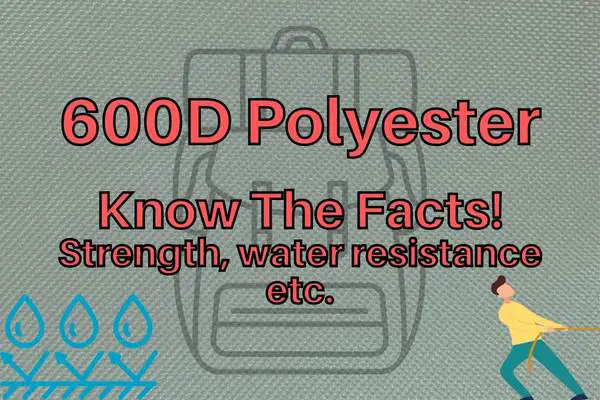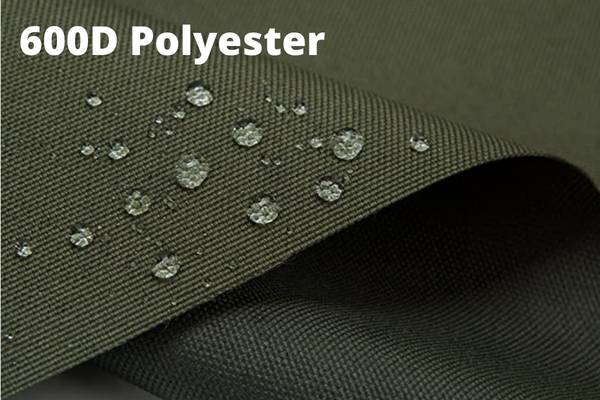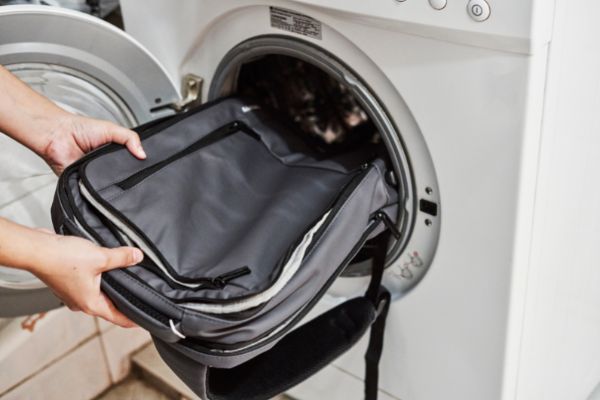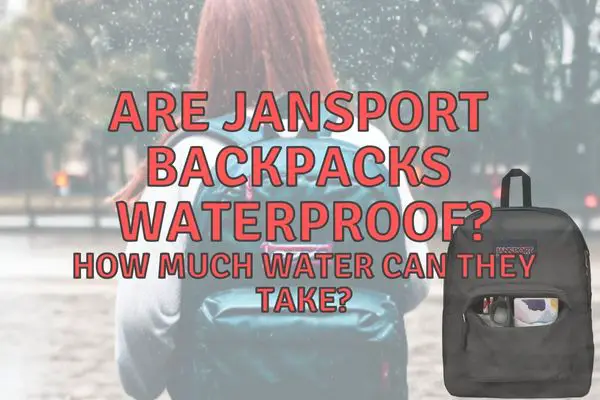Jansport makes a lot of different backpacks, and they are made from different materials that resist water to different degrees, but very few of their models are completely waterproof.
So, the short answer is: no, Jansport backpacks are generally not waterproof, but many of their backpacks are water resistant.
Their most popular models like the MAIN CAMPUS, RIGHT PACK or SUPERBREAK backpacks are mode from 600D polyester, which will keep your stuff dry in a short rain shower, but are not considered fully waterproof.
However, there are ways to make them more resistant to water. In this blog post, I’ll share some tips on how to make your Jansport backpack more water resistant.
Contents
What are Jansport backpacks made of?
Most of Jansports backpacks are made from polyester, but some model have nylon or polyurethane mixed in.
A few models are also made from canvas and some have vinyl parts as a sort of synthetic leather feature.
Generally, the backpacks made from a mixing in nylon with polyester are stronger, but not necessarily more waterproof. In this case though, the Agave backpack has a higher water resistance rating than that of the SuperBreak.
JanSport also offer newer backpacks with enhanced bottom material such as the synthetic leather of their Student and Cortlandt backpacks:
This leather enhancement makes the backpacks virtually waterproof in the bottom, but still not entirely rainproof.
But the vast majority of Jansport packs are made from 600D polyester, to which I have already dedicated a whole article.
Polyester is a synthetic fabric that has been used for decades in clothing and other products. It is durable, water resistant, and strong.
600D fabric is used extensively in backpacks and is not only used in the JanSport backpack series but also in the well known Eastpak backpacks.
When we talk about 100D, 200D, 500D, or 600D polyester, the “D” designation denotes the thickness of the thread used to construct the fabric.

A 600D thread corresponds to the thread weighing 600 grams (1.32 lbs) per 9000 meters (5.6 miles) of the pure thread.
How much the fabric woven from 600D polyester weighs and how tough and water resistant it is, depends on the weaving method used to make the fabric.
However, the average 600D fabric will weigh somewhere between 100-250 grams per square meter or 0.3 to 0.81 oz per square foot.
And as a rule of thumb 600D polyester can stand 1000-2000mm hydrostatic water pressure in most backpacks.
Is 600D Polyester Waterproof?
Due to its nature as an oil based plastic, it repels water, but some water does slip through the tiny holes between the threads in the weaved fabric, so polyester backpacks are not 100% waterproof without any extra treatment.
Polyester fabrics backpacks will keep dry during a brief rain shower, but will eventually soak through.
The thicker polyester material, the more water resistant it will be and if you apply a good water proofing spray that can become virtually waterproof.
Polyester is made from a synthetic polymer and is used in a wide variety of products ranging from clothing, backpacks, jackets and tents. It has excellent strength properties and is highly durable for its weight.
So, does that mean 600D polyester fabric is always waterproof? The answer is no, as it depends on how it is treated and how tightly the fabric is woven.
That is, how many threads per inch – the threat count, sometimes designated “T” in the fabric designation but should not be confused with the thread thickness unit “Tex”.

The fabric made from 600D polyester can be more or less water resistant depending on a few factors I will get into below.
As a rule of thumb, untreated 600D polyester (ordinary or oxford fabric) can withstand a water column pressure of 1000mm to 2000mm, whereas PVC, PU, or silicon coated (silnylon) textiles can hold back a water column pressure of more than 10000mm.
The waterproofness of 600D polyester can also be affected by abrasion. The more the fabric is used, the more likely it is that the water repellent treatments will become worn away and need to be reapplied.
Like other materials such as nylon or polyester used for raingear or the nylon used for backpacks, the type of surface coating is essential for water resistance!
Whereas untreated 600D polyester is water resistant if the fabric is tightly woven, it is often treated with silicon, PVC, or other water repellant chemicals to seal the small holes in between the threads where water might enter if the water column pressure is high enough.
Polyurethane coating is another widely used synthetic polymer that is applied to fabrics in order to make them waterproof. This type of coating is often used on outdoor gear, such as jackets, backpacks and tents.
What is the difference between water resistant and waterproof?
Most Jansport backpacks are rated as water resistant rather than water proof, but what exactly does that mean?
Waterproofing is a property of materials that prevents moisture from passing through them. This means that when water hits a surface, it will not penetrate the material at all.
However, some materials are more effective at preventing water penetration than others and those that will eventually allow some water to come through are termed “water resistant” rather than waterproof.
Waterproof fabrics will keep out water, while water resistant fabrics will allow some moisture to pass through.
In essence, if you wear a pair of pants made with a water-resistant fabric, you should avoid getting them wet for longer periods of time, whereas if you wear a pair of rain pants made with a water-resistant fabric, you should not worry about getting them wet.
Are all polyester backpacks equally water resistant?
While most Some Jansport backpacks are made from 600D polyester, thinner polyester fabrics are most often going to be less waterproof but cheeper and lighter.
No, only the very thick polyesters such as those tightly weaved with thread densities above 100D can be considered fully waterproof if also treated with a good water repellent.
However, no polyester fabric is completely waterproof and even most polyester tent flysheets will eventually let some water through during heavy rain.
Most often waterproof polyester fabrics will be a blend of more than one polymer and typically a waterproof layer is applied on top.
Polyester can be made virtually waterproof if treated with a layer of silicon or PU (polyurethane) to make sure that no water gets through.
This is often used in rain jackets and pants and for 600D polyester to make backpacks waterproof.
What Jansport backpacks are waterproof?
Wheres the most popular backpacks from Jansport are made from untreated 600D polyester, they have a few models where other materials are added or mixed in to make the backpacks more waterproof.
The Jansport Chill Pack is made with TPU Coated 600D Ripstop Polyester, which means that it is practically waterproof in normal everyday use and the occasional heavy rain shower.
Other Jansport backpacks, like the Agave backpack shown below, are made from thick nylons, which makes them very water resistant but not 100% waterproof.
How Do I Make My Jansport Backpack More Waterproof?
Sure, there are many ways to make a Jansport backpack more waterproof! The best options are:
1. Using a silicon or DWR spray.
2. Using waterproofing detergent.
3. Using an internal waterproof liner or a rain cover.
Using waterproofing sprays
If you want to keep your backpack and its contents dry in wet weather, the easiest option is to use a silicon or DWR spray to make it more waterproof.
Here’s a step-by-step guide:
- Start by thoroughly cleaning your backpack with soap and water. This will help the DWR or silicon spray to adhere better.
- Once your backpack is clean, shake the spray can well and apply it evenly to the surface of the backpack.
- Allow the silicon/DWR spray to dry completely before using or storing your backpack inside!
It is best to perform this treatment outdoors as these sprays are not healthy to inhale, but they can also be performed in a well-ventilated room.
Using DWR waterproofing detergent
Another way to make your Jansport backpack more waterproof is by using DWR detergent. This type of detergent can be found at most outdoor or camping stores and it is applied during washing in a laundry machine.
While not made specifically for backpacks, the same DWR products that are used for jackets can also be used for most types of nylon backpacks as many rain jackets are also made from polyester.
DWR is most often made from fluoropolymers. Fluoropolymers are a type of synthetic polymer that contains fluorine atoms – a bit like a teflon pan!
This gives the polymer material water-repellent and non-stick properties. Fluoropolymers are often used to coat fabric or other materials to make them waterproof.
They perform well in very wet weather but can be damaged by heat and sunlight. They are also quite expensive and will wash off with time.
To use it, simply follow these steps:
- First, make sure to remove loose strings and all the contents of the pack!
- Next, if your pack is very dirty, clean it with soap and water to remove most of the dirt or debris.
- Put your backpack in the washing machine and follow the washing instructions on the detergent bottle. Usually, a medium-temperature program with slow centrifugation at the end is recommended.
- Dry the backpack. Sometimes, depending on the product used, it is recommended to use a tumble drier but this is only necessary when you use these detergents for membrane rain jackets. I would always recommend air drying as the heat of a tumble drier may damage the nylon.
- If you find that your backpack is still not waterproof after following these steps, you may need to reapply the DWR detergent, use more of it, or consider using a different type of waterproofing treatment.
Always remember to be careful with the washing program for a backpack, and always read the instructions on the label of the detergent.

Also, if you have a backpack with a metal frame, either remove the metal parts or use one of my other methods listed here.
And, after washing with a DWR detergent, do not be afraid of putting your pack in the dryer – but read my instructions here first!
Using an internal waterproof liner or an outer rain cover
This method is the most efficient but does require some modification of the pack, which may or may not be doable depending on the model.
Here is a general method:
- Purchase a waterproof backpack liner made from a waterproof material. An ordinary PE plastic bag in the right size may also be used!
- Place the liner inside your backpack, making sure that it covers the entire interior surface area.
- Close up your backpack and cinch all of the straps tight so that the liner is held in place.
- If necessary, use duct tape or another adhesive to further secure the liner to the interior of your backpack.
An external rain cover is also an efficient solution as you do not have to do anything to the backpack and it often makes it fully waterproof.
The downside is that you will have to carry it around and that it may be impractical to put on and access equipment when on.
Can you make a Jansport backpack completely waterproof?
Without using a rain cover, it is hard to make a nylon backpack completely waterproof, but it can be made very water repellant.
A rain cover is also a good option to protect your Jansport backpack against the rain, without the need for a 100% waterproof pack.
DWR and silicon spray can get you a long way, but it will not make a pack made from thin nylon fabric of less than 400D completely waterproof.
Which backpack materials are completely waterproof?
While Jansport packs are made mostly from thick polyester, this will never be 100% waterproof without any addtional materials added.
The most waterproof backpack materials are: Polyurethane (PU), Dyneema, Rubber, polyvinyl chloride (PVC), silicone elastomer, and leather.
I will go through each of these materials in more detail below.
Polyurethane
Of the materials listed here, polyurethane is the most widely used for modern waterproof backpacks. It has a rubber-like feel to it and is completely waterproof – to the extent that you can use it for swimming and kayaking!
Here are three examples of some good quality PU backpacks:
Polyurethane is as waterproof but much lighter than the PVC material, which is also often used in the manufacture of backpacks. But PVC is not great for the environment.
It is also much lighter in weight than rubber, and also more comfortable to wear as it allows some breathability. Polyurethane is also resistant to degradation from heat and sunlight.
Dyneema
While not widely used, Dyneema is the technically most advanced fabric!
Dyneema is a high-performance polyethylene fiber that is used in a variety of applications where strength, durability, and lightweight properties are desired.
The material is often used in outdoor gear and equipment, such as backpacks, as it is waterproof and resistant to abrasion.
I will not go further into this material as I already wrote an article comparing it to nylon here.
Do you know the difference between nylon and polyester and that polyester is widely used for rain gear, sleeping bags, tents, and sleeping pads? And do you know how it impacts the functionality? I wrote an article about the fabric type and its impact on rain gear and a post on sleeping pads here.
Take a look at my favorite lightweight backpacks or check out my post on how to choose an inflatable sleeping pad that is not noisy to sleep on.
Other materials like thin 7D to 40D nylons and the extremely durable and waterproof Dyneema material are also used more and more in outdoor gear.
Rubber
If you have ever worn a pair of rubber boots, you will know how waterproof rubber is!
Rubber is perhaps the oldest material used to make waterproof packs. Backpacks made with waterproof rubber are ideal for use in very wet weather, as they will keep the contents of the backpack completely dry.
However, rubber has a tendency to fall apart and degrade when exposed to heat and sunlight. It is also heavy in use and somewhat cold and uncomfortable to wear on your bag as no breathing through the material is allowed.
Silicone elastomer is a type of rubber that is used in many waterproof products, including backpacks. It is very durable and can withstand exposure to sunlight and heat better without degrading.
However, as traditional rubber, it is not lightweight or very comfortable to wear.
PVC
PVC is a synthetic plastic that is also used to make waterproof backpacks. PVC is fairly lightweight, durable, and inexpensive, making it a popular choice for backpack manufacturers. It is also easy to make in many different colors.
However, PVC is not as environmentally friendly as some other materials and can be toxic if it melts or burns. Therefore it is prohibited in many countries.
Leather
Leather is a naturally waterproof material, and it has been used to make backpacks for centuries. Leather packs are very tough and durable, making them ideal for use in rugged conditions.

However, leather is not as breathable as other materials, so it can be uncomfortable to wear in hot weather. It is also more expensive and quite heavy to carry!
What are other good waterproof backpacks?
There are many different brands offering waterproof and functional backpacks out there. I particularly like the Scandinavian brand Fjällräven as they offer a few modern options that can also be used for everyday purposes.
Waterproof backpacks from Fjällräven
If you are a returning reader of my blog, you will know that I have already written a post about waterproof backpacks from Fjällräven.
Fjällräven makes a ton of outdoor gear, including backpacks, that are often made from G-1000 fabric or their so-called “Vinylon F” material.
G-1000 is a material that is used in high-end backpacks. If it is treated with so-called “Greenland wax”, it can be made highly waterproof and can withstand a lot of abuse. It is also quite comfortable to wear, as it is breathable and the backpacks made from it usually have a lot of padding.
I personally own and enjoy their Abisko hiking backpack, which is so durable and functional that I believe will last me the rest of my days… It is made from G-1000 so it can be made fully waterproof by applying Greenland Wax.
Vinylon F is a synthetic fiber that is often used to make waterproof packs. This material is strong and tear-resistant, making it ideal for use in harsh conditions. It is also lightweight and comfortable to wear, making it a good choice for long hikes. However, Vinylon F can be expensive and difficult to find.
Fjällräven also offers several fully waterproof backpacks made from their BERGSHELL fabric. BERGSHELL means mountain shell and is a strong and waterproof fabric containing 400D nylon fused with TPU to make it fully waterproof.
Examples of fully waterproof backpacks from Fjällräven are the Bergtagen and Keb rucksack for hiking and the Ulvö for every day (school and work) activities.
The Ulvö rolltop variant of the Ulvö backpack has a closing mechanism similar to waterproof stuff sacks that makes it even harder for water to enter. If you are looking for a completely waterproof alternative to the Kankan rucksack, the Ulvö pack may be a perfect choice.
Some other 100% waterproof options you should check out are from Teton, Earth Pak and Muzee.
These will all be great alternatives to a JanSport backpack if you need an absolute waterproof backpack.
A downside of 100% waterproof backpacks, as with any waterproof material, is that they are less breathable and you will usually get a bit sweaty on your back if you do exercise e.g. biking or running with the backpack.

























